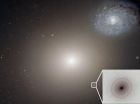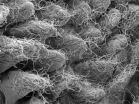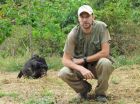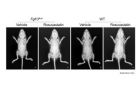(Press-News.org) SALT LAKE CITY, Sept. 17, 2014 – A University of Utah astronomer and his colleagues discovered that an ultracompact dwarf galaxy harbors a supermassive black hole – the smallest galaxy known to contain such a massive light-sucking object. The finding suggests huge black holes may be more common than previously believed.
"It is the smallest and lightest object that we know of that has a supermassive black hole," says Anil Seth, lead author of an international study of the dwarf galaxy published in Thursday's issue of the journal Nature. "It's also one of the most black hole-dominated galaxies known."
The astronomers used the Gemini North 8-meter optical-and-infrared telescope on Hawaii's Mauna Kea and photos taken by the Hubble Space Telescope to discover that a small galaxy named M60-UCD1 has a black hole with a mass equal to 21 million suns.
Their finding suggests plenty of other ultracompact dwarf galaxies likely also contain supermassive black holes – and those dwarfs may be the stripped remnants of larger galaxies that were torn apart during collisions with yet other galaxies.
"We don't know of any other way you could make a black hole so big in an object this small," says Seth, an assistant professor of physics and astronomy at the University of Utah. "There are a lot of similar ultracompact dwarf galaxies, and together they may contain as many supermassive black holes as there are at the centers of normal galaxies."
Black holes are collapsed stars and collections of stars with such strong gravity that even light is pulled into them, although material around them sometimes can spew jets of X-rays and other forms of radiation. Supermassive black holes – those with the mass of at least 1 million stars like our sun – are thought to be at the centers of many galaxies.
The central, supermassive black hole at the center of our Milky Way galaxy has the mass of 4 million suns, but as heavy as that is, it is less than 0.01 percent of the galaxy's total mass, estimated at some 50 billion solar masses.
By comparison, the supermassive black hole at the center of ultracompact dwarf galaxy M60-UCD1 is five times larger than the Milky Way's, with a mass of 21 million suns, and is a stunning 15 percent of the small galaxy's total mass of 140 million suns.
"That is pretty amazing, given that the Milky Way is 500 times larger and more than 1,000 times heavier than the dwarf galaxy M60-UCD1," Seth says.
"We believe this once was a very big galaxy with maybe 10 billion stars in it, but then it passed very close to the center of an even larger galaxy, M60, and in that process all the stars and dark matter in the outer part of the galaxy got torn away and became part of M60," he says. "That was maybe as much as 10 billion years ago. We don't know."
Seth says ultracompact dwarf galaxy M60-UCD1 may be doomed, although he cannot say when because the dwarf galaxy's orbit around M60 isn't known. M60 is among the largest galaxies in what astronomers refer to as "the local universe."
"Eventually, this thing may merge with the center of M60, which has a monster black hole in it, with 4.5 billion solar masses – more than 1,000 times bigger than the supermassive black hole in our galaxy. When that happens, the black hole we found in M60-UCD1 will merge with that monster black hole."
Galaxy M60 also is pulling in another galaxy, named NGC4647. M60 is about 25 times more massive than NGC4647.
Ultracompact Dwarf Galaxies and Supermassive Black Holes
The study – conducted by Seth and 13 other astronomers – was funded by the National Science Foundation in the U.S., the German Research Foundation and the Gemini Observatory partnership, which includes the NSF and scientific agencies in Canada, Chile, Australia, Brazil and Argentina.
Ultracompact dwarf galaxies are among the densest star systems in the universe. M60-UCD1 is the most massive of these systems now known, with a total of 140 million solar masses.
These dwarf galaxies are less than a few hundred light years across (about 1,700 trillion miles wide), compared with our Milky Way's 100,000-light-year diameter.
M60-UCD1 is roughly 54 million light years from Earth or about 320 billion billion miles. But the dwarf galaxy is only 22,000 light years from the center of galaxy M60, which "is closer than the sun is to the center of the Milky Way," Seth says.
Astronomers have debated whether these dwarf galaxies are the stripped centers or nuclei of larger galaxies that were ripped away during collisions with other galaxies, or whether they formed like globular clusters – groups of perhaps 100,000 stars, all born together. There are about 200 globular clusters in our Milky Way, and some galaxies have thousands, Seth says.
The astronomers estimated the mass of the dwarf galaxy's supermassive black hole by using the Gemini North telescope to measure the speed and motion of stars in orbit around it, and they showed the galaxy contains more mass than would be expected by the amount of starlight it emits. The stars at the center of M60-UCD1 move at about 230,000 mph – faster than stars would be expected to move without the black hole.
An alternate theory is that M60-UCD1 doesn't have a supermassive black hole, but instead is populated by a lot of massive, dim stars.
But Seth says the research team's observations with the Gemini North telescope and analysis of archival photos by the Hubble Space Telescope revealed that mass was concentrated in the galaxy's center, indicating the presence of a supermassive black hole. That suggests that M60-UCD1 is the stripped nucleus of what once was a much larger galaxy, and that other ultracompact dwarf galaxies also may harbor huge black holes, Seth says.
The galaxy that was stripped and left M60-UCD1 as a remnant was about 10 billion solar masses, or about one-fifth the mass of the Milky Way, Seth says.
The astronomers studied M60-UCD1 because they had published a paper last year showing the galaxy was an X-ray source and was extremely dense. The X-ray emissions suggest gas is being sucked into the black hole at a rate typical of supermassive black holes in much larger galaxies.
INFORMATION:
The Research Facilities and Team
The Gemini Observatory is an international collaboration with two identical 8-meter telescopes: Gemini North on the island of Hawaii and Gemini South on Cerro Pachón in central Chile. Together, the telescopes cover both hemispheres of the sky. The telescopes incorporate technologies that allow large, relatively thin and actively controlled mirrors to collect and focus infrared light from space, eliminating the blurring effects of the atmosphere and enabling the observations for the new study. The observatory is managed by the Association of Universities for Research in Astronomy under a cooperative agreement with the National Science Foundation.
The Hubble Space Telescope was built by NASA and the European Space Agency and is operated by the Space Telescope Science Institute.
Seth conducted the study with University of Utah physics and astronomy postdoctoral researcher Mark den Brok and with astronomers Remco van den Bosch of the Max Planck Institute for Astronomy, Germany; Steffen Mieske of the European Southern Observatory, Santiago, Chile; Holger Baumgardt of the University of Queensland, Australia; Jay Strader of Michigan State University; Nadine Neumayer and Michel Hilker of the European Southern Observatory, Garching, Germany; Igor Chilingarian of the Smithsonian Astrophysical Observatory in Cambridge, Massachusetts, and Moscow State University; Richard McDermid and Lee Spitler of Asutralia's Macquarie University; Jean Brodie of the University of California, Santa Cruz; Matthias J. Frank of the University of Heidelberg, Germany; and Jonelle Walsh of the University of Texas, Austin.
Video Link
A video simulation of galaxy M60's gravity stripping M60-UCD1's outer parts is here:
http://vimeo.com/105370891
Until the embargo expires, media may use the case-sensitive password: Baumgardt
Caption and credit for video:
Formation of Dwarf Galaxy M60-UCD1: University of Utah astronomer Anil Seth led an international research team that discovered the smallest galaxy known to harbor a supermassive black hole. The video simulation shows how this small galaxy, named M60-UCD1, was formed from a larger, normal galaxy. The video begins with a background image made by the Hubble Space Telescope, with the huge elliptical galaxy M60 in the center, galaxy NGC4647 in the upper right and MC60-UCD as a small whitish spot lower right. As the video begins, a normal galaxy (yellow and red) orbits M60. During an estimated 500 million years, M60's gravity strips stars (red material) from the orbiting galaxy, leaving as a remnant the ultracompact dwarf galaxy now known as M60-UCD1. The end of the video zooms in on the Hubble Space Telescope close-up image of M60-UCD1, which today continues to orbit M60. Seth says that while this process took about 500 million years, astronomers don't know when it happened, and that it could have been billions of years ago. This video was made by University of Queensland astronomer Holger Baumgardt, one of Seth's co-authors on the new study published by Nature.
Credit: Holger Baumgardt, University of Queensland.
University of Utah Communications
75 Fort Douglas Boulevard, Salt Lake City, UT 84113
801-581-6773 fax: 801-585-3350
http://www.unews.utah.edu
Smallest known galaxy with a supermassive black hole
Many black holes may hide in dwarf remnants of stripped galaxies
2014-09-17
ELSE PRESS RELEASES FROM THIS DATE:
Gut bacteria, artificial sweeteners and glucose intolerance
2014-09-17
Artificial sweeteners, promoted as aids to weight loss and diabetes prevention, could actually hasten the development of glucose intolerance and metabolic disease; and they do it in a surprising way: by changing the composition and function of the gut microbiota – the substantial population of bacteria residing in our intestines. These findings, the results of experiments in mice and humans, were published today in Nature. Among other things, says Dr. Eran Elinav of the Weizmann Institute's Immunology Department, who led this research together with Prof. Eran Segal of Computer ...
New branch added to European family tree
2014-09-17
The setting: Europe, about 7,500 years ago.
Agriculture was sweeping in from the Near East, bringing early farmers into contact with hunter-gatherers who had already been living in Europe for tens of thousands of years.
Genetic and archaeological research in the last 10 years has revealed that almost all present-day Europeans descend from the mixing of these two ancient populations. But it turns out that's not the full story.
Researchers at Harvard Medical School and the University of Tübingen in Germany have now documented a genetic contribution from a third ancestor: ...
Natural born killers: Chimpanzee violence is an evolutionary strategy
2014-09-17
ANN ARBOR—Man's nearest relatives kill each other in order to eliminate rivals and gain better access to territory, mates, food or other resources—not because human activities have made them more aggressive.
That is the conclusion of an international analysis of lethal aggression among different groups of chimpanzees in Africa studied over five decades. The research appears in the current issue of Nature.
"Observations that chimpanzees kill members of their own species have influenced efforts to understand the evolution of human violence," said University of Michigan ...
What set the Earth's plates in motion?
2014-09-17
The mystery of what kick-started the motion of our earth's massive tectonic plates across its surface has been explained by researchers at the University of Sydney.
"Earth is the only planet in our solar system where the process of plate tectonics occurs," said Professor Patrice Rey, from the University of Sydney's School of Geosciences.
"The geological record suggests that until three billion years ago the earth's crust was immobile so what sparked this unique phenomenon has fascinated geoscientists for decades. We suggest it was triggered by the spreading of early ...
Nature of war: Chimpanzees inherently violent according to study
2014-09-17
(Chicago) -- Of all of the world's species, humans and chimpanzees are some of the only to engage in coordinated attacks on other members of their same species. Jane Goodall was among the first to introduce the occurrence of lethal inter-community killings and since then primatologists and anthropologists have long debated the concept of warfare in this genus. Research theories have pointed to increased gains and benefits of killing off competitors and opening up increased access to key resources such as food or mates. In contrast, others have argued that warfare is a result ...
Modern Europeans descended from three groups of ancestors
2014-09-17
New studies of ancient DNA are shifting scientists' ideas of how groups of people migrated across the globe and interacted with one another thousands of years ago. By comparing nine ancient genomes to those of modern humans, Howard Hughes Medical Institute (HHMI) scientists have shown that previously unrecognized groups contributed to the genetic mix now present in most modern-day Europeans.
"There are at least three major, highly differentiated populations that have contributed substantial amounts of ancestry to almost everybody that has European ancestry today," says ...
Chimpanzee lethal aggression a result of adaptation rather than human impacts
2014-09-17
In the 1970s, Jane Goodall's reports of chimpanzee violence caught the attention of a global audience. Since then, many people have compared chimpanzee intergroup aggression to primitive warfare and have argued that chimpanzee violence is an adaptive strategy that gives the perpetrators an edge. Others have argued that lethal aggression is the consequence of human activities such as provisioning (artificial feeding) by researchers or habitat destruction. A new study of the pattern of intergroup aggression in chimpanzees and their close relatives, bonobos (also called pygmy ...
Researchers use iPS cells to show statin effects on diseased bone
2014-09-17
Skeletal dysplasia is a group of rare diseases that afflict skeletal growth through abnormalities in bone and cartilage. Its onset hits at the fetal stage and is caused by genetic mutations. A mutation in the gene encoding fibroblast growth factor receptor 3 (FGFR3) has been associated with two types of skeletal dysplasia, thanatophoric dysplasia (TD), a skeletal dysplasia that cause serious respiratory problems at birth and is often lethal, and achondroplasia (ACH), which causes stunted growth and other complications throughout life. Several experimental treatments have ...
Math model designed to replace invasive kidney biopsy for lupus patients
2014-09-17
COLUMBUS, Ohio – Mathematics might be able to reduce the need for invasive biopsies in patients suffering kidney damage related to the autoimmune disease lupus.
In a new study, researchers developed a math model that can predict the progression from nephritis – kidney inflammation – to interstitial fibrosis, scarring in the kidney that current treatments cannot reverse. A kidney biopsy is the only existing way to reach a definitive diagnosis of the damage and its extent.
The model could also be used to monitor the effectiveness of experimental treatments for inflammation ...
Large study reveals new genetic variants that raise risk for prostate cancer
2014-09-17
In an analysis of genetic information among more than 87,000 men, a global team of scientists says it has found 23 new genetic variants – common differences in the genetic code -- that increase a man's risk for prostate cancer. The so-called "meta-analysis," believed to be the largest of its kind, has revealed once hidden mutations among men in a broad array of ethnic groups comprising men of European, African, Japanese and Latino ancestry.
The meta-analysis combined information from smaller studies, according to William B. Isaacs, Ph.D., a genetic scientist at the Brady ...
LAST 30 PRESS RELEASES:
University of Oklahoma researcher awarded funding to pursue AI-powered material design
Exploring how the visual system recovers following injury
Support for parents with infants at pediatric check-ups leads to better reading and math skills in elementary school
Kids’ behavioral health is a growing share of family health costs
Day & night: Cancer disrupts the brain’s natural rhythm
COVID-19 vaccination significantly reduces risk to pregnant women and baby
The role of vaccination in maternal and perinatal outcomes associated with COVID-19 in pregnancy
Mayo Clinic smartwatch system helps parents shorten and defuse children's severe tantrums early
Behavioral health spending spikes to 40% of all children’s health expenditures, nearly doubling in a decade
Digital cognitive behavioral treatment for generalized anxiety disorder
Expenditures for pediatric behavioral health care over time and estimated family financial burden
Air conditioning in nursing homes and mortality during extreme heat
The Alps to lose a record number of glaciers in the next decade
What makes a good proton conductor?
New science reporting guide published for journalists in Bulgaria
New international study reveals major survival gaps among children with cancer
New science reporting guide published for journalists in Turkey
Scientists develop a smarter mRNA therapy that knows which cells to target
Neuroanatomy-informed brain–machine hybrid intelligence for robust acoustic target detection
Eight SwRI hydrogen projects funded by ENERGYWERX
The Lundquist Institute and its start-up company Vitalex Biosciences Announces Strategic Advancement of Second-Generation fungal Vaccine VXV-01 through Phase 1 Trials under $40 Million Competitive Con
Fine particles in pollution are associated with early signs of autoimmune disease
Review article | Towards a Global Ground-Based Earth Observatory (GGBEO): Leveraging existing systems and networks
Penn and UMich create world’s smallest programmable, autonomous robots
Cleveland researchers launch first major study to address ‘hidden performance killer’ in athletes
To connect across politics, try saying what you oppose
Modulating key interaction prevents virus from entering cells
Project explores barriers to NHS career progression facing international medical graduates
Jeonbuk National University researchers explore the impact of different seasonings on the flavor perception of Doenjang soup
Two Keck Medicine of USC Hospitals named Leapfrog Top Teaching Hospitals
[Press-News.org] Smallest known galaxy with a supermassive black holeMany black holes may hide in dwarf remnants of stripped galaxies






